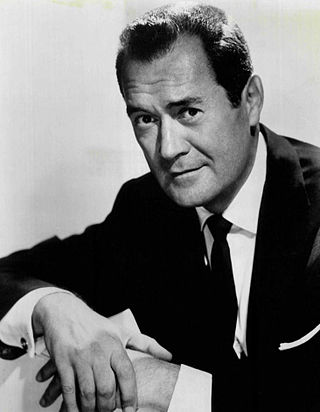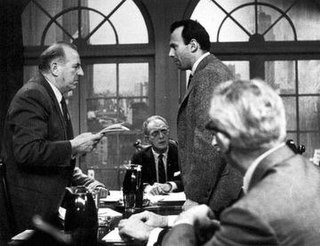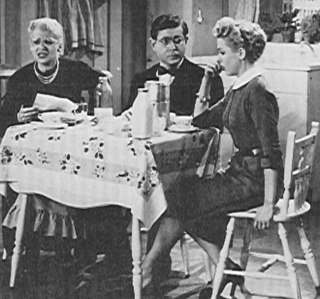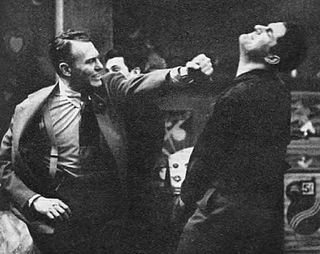Related Research Articles

Armstrong Circle Theatre is an American anthology drama television series which ran from June 6, 1950, to June 25, 1957, on NBC, and from October 2, 1957, to August 28, 1963, on CBS. It alternated weekly with The U.S. Steel Hour. It finished in the Nielsen ratings at number 19 for the 1950–1951 season and number 24 for 1951–1952. The principal sponsor was Armstrong World Industries.
Hollywood Screen Test is an American talent show that aired on ABC from 1948 to 1953. This program holds the distinction as the first regularly broadcast television series by the American Broadcasting Company.

Mr. District Attorney is a radio crime drama produced by Samuel Bischoff that aired on NBC and ABC from April 3, 1939 to June 13, 1952. The series focused on a crusading district attorney initially known only as Mister District Attorney or Chief, and was later translated to television. On television, the attorney's name was Paul Garrett, and the radio version adopted the name in its final years when David Brian played the role. A key figure in the dramas was secretary Edith Miller.

Frank Andrew Lovejoy Jr. was an American actor in radio, film, and television. He is perhaps best remembered for appearing in the film noir The Hitch-Hiker and for starring in the radio drama Night Beat.

Lux Video Theatre is an American television anthology series that was produced from 1950 until 1957. The series presented both comedy and drama in original teleplays, as well as abridged adaptations of films and plays.

Kraft Television Theatre is an American anthology drama television series running from 1947 to 1958. It began May 7, 1947 on NBC, airing at 7:30pm on Wednesday evenings until December of that year. It first promoted MacLaren's Imperial Cheese, which was advertised nowhere else. In January 1948, it moved to 9pm on Wednesdays, continuing in that timeslot until 1958. Initially produced by the J. Walter Thompson advertising agency, the live hour-long series offered television plays with new stories and new characters each week, in addition to adaptations of such classics as A Christmas Carol and Alice in Wonderland. The program was broadcast live from Studio 8-H at 30 Rockefeller Plaza, currently the home of Saturday Night Live.

The First Hundred Years is the first ongoing TV soap opera in the United States that began as a daytime serial, airing on CBS from December 4, 1950 until June 27, 1952.
CBS Television Workshop is an American anthology series that aired on CBS from January 13, 1952, to April 13, 1952. The series is noted for featuring early television appearances of several well known actors, including Audrey Hepburn, James Dean, Sidney Poitier and Grace Kelly. The title was also used for a 1960 series.

Meet Millie, a situation comedy about a wisecracking Manhattan secretary from Brooklyn, made a transition from radio to television in the early 1950s. In the live television version, Mom and Millie were living in Jackson Heights, Queens. The popularity of this series led to a four-year run on CBS Television.
Martin Kane, Private Eye is an American crime drama radio and television series sponsored by United States Tobacco Company. It aired via radio from 1949 to 1952 and was simultaneously a television series on NBC from 1949 to 1954. It was the "earliest of successful cops-and-robbers series" on television.

Alcoa Theatre is a half-hour American anthology series telecast on NBC at 9:30 pm on Monday nights from September 30, 1957 to May 23, 1960. For its first four months on the air, the title Turn of Fate was used as an umbrella title for Alcoa Theatre and its alternate-week counterpart, Goodyear Theatre.

Craig Rice was an American writer of mystery novels and short stories, described by book critic Bill Ruehlmann as "the Dorothy Parker of detective fiction, she wrote the binge and lived the hangover."

Man Against Crime starring Ralph Bellamy, one of the first television programs about private eyes, ran on CBS, the DuMont Television Network and NBC from October 7, 1949, to June 27, 1954, and was briefly revived, starring Frank Lovejoy, during 1956. The show was created by Lawrence Klee and was broadcast live until 1952. The series was one of the few television programs ever to have been simulcast on more than one network: the program aired on both NBC and DuMont during the 1953–54 television season.

Suspense is an American television anthology series that ran on CBS Television from 1949 to 1954. It was adapted from the radio program of the same name which ran from 1942 to 1962.
The Red Buttons Show premiered on the CBS television network on October 14, 1952, and ran for two years on that network, then moved to NBC for the final 1954–55 season.
Treasury Men in Action is an American crime drama series broadcast live and which aired from September 11, 1950, through April 1951 on ABC and then on NBC through 1955. The series stars Walter Greaza, Ross Martin, and Tom McKee.

Danger is a CBS television dramatic anthology series that began on September 26, 1950, and ended on May 31, 1955. Its original title was Amm-i-dent Playhouse. The show "was one of the first television dramatic series to make effective use of background music"
The Amazing Mr. Malone is an American radio crime drama series based on the John Malone series of mystery novels by Craig Rice. The series ran on ABC from January 11, 1947, through September 24, 1950, and was broadcast on NBC Radio from May 25, 1951, through July 13, 1951.

We the People is an American talk show aired on CBS Television (1948-1949) and then on NBC Television (1949-1952).
Hollywood Opening Night is an American anthology television program that was broadcast on CBS in 1951-1952 and on NBC in 1952-1953. The NBC version was the first dramatic anthology presented live from the West Coast. Episodes were 30 minutes long.
References
- 1 2 3 4 5 Erickson, Hal (October 21, 2009). Encyclopedia of Television Law Shows: Factual and Fictional Series About Judges, Lawyers and the Courtroom, 1948-2008. McFarland. pp. 35–36. ISBN 978-0-7864-5452-5 . Retrieved January 18, 2024.
- ↑ McNeil, Alex (1996). Total Television: the Comprehensive Guide to Programming from 1948 to the Present (4th ed.). New York, New York: Penguin Books USA, Inc. p. 36. ISBN 0-14-02-4916-8.
- 1 2 3 Terrace, Vincent (October 6, 2022). From Radio to Television: Programs That Made the Transition, 1929-2021. McFarland. p. 19. ISBN 978-1-4766-8836-7 . Retrieved January 18, 2024.
- ↑ "Monday October 8". Ross Reports. October 7, 1951. p. 7. Retrieved January 18, 2024.
- ↑ "Monday October 22 (Cont'd)". Ross Reports. October 21, 1951. p. 7. Retrieved January 18, 2024.
- ↑ "Monday November 5". Ross Reports. November 4, 1951. p. 6. Retrieved January 18, 2024.
- ↑ "Monday November 19 (Cont'd)". Ross Reports. November 18, 1951. p. 6. Retrieved January 18, 2024.
- ↑ "Monday December 3" (PDF). Ross Reports. December 2, 1951. p. 6. Retrieved January 18, 2024.
- ↑ "Monday December 17". Ross Reports. December 16, 1951. p. 7. Retrieved January 20, 2024.
- ↑ "Monday December 31 (Cont'd)". Ross Reports. December 30, 1951. p. 8. Retrieved January 20, 2024.
- ↑ "Monday February 11". Ross Reports. February 10, 1952. p. 8. Retrieved January 19, 2024.
- ↑ "Monday February 25". Ross Reports. February 24, 1952. p. 8. Retrieved January 20, 2024.
- ↑ "List of Properties Used on TV Dramas - November 17, 1951 Through June 30, 1952". Ross Reports. 1952. p. 1. Retrieved January 20, 2024.
- ↑ "Loss of 11 Clients To Cost ABC $8 Mil". Variety. March 1, 1952. p. 6. Retrieved January 18, 2024.
- ↑ Brooks, Tim; Marsh, Earle F. (June 24, 2009). The Complete Directory to Prime Time Network and Cable TV Shows, 1946-Present. Random House Publishing Group. p. 42. ISBN 978-0-307-48320-1 . Retrieved January 18, 2024.
- ↑ "This Week -- Network Debuts, Highlights, Changes". Ross Reports. March 9, 1952. p. 1. Retrieved January 20, 2024.
- 1 2 Morse, Leon (October 6, 1951). "Lee Tracy, Sock Support Bring Credibility to 'Amazing Malone'". Billboard. p. 3. Retrieved January 18, 2024.
- 1 2 Newton, Dwight (October 15, 1951). "Day and Night with Radio and Television". San Francisco Examiner. p. 24. Archived from the original on January 18, 2024. Retrieved January 18, 2024– via Newspapers.com.
- 1 2 "Amazing Mr. Malone". Variety. September 26, 1951. p. 119. Retrieved January 20, 2024.